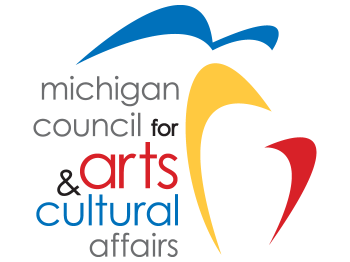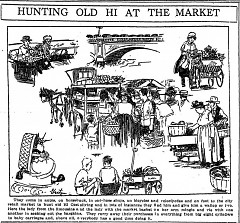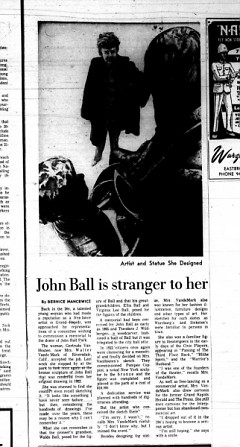The Cartoonists of Grand Rapids exhibit uncovers a rich history of local cartoonists biographies and artwork, and will be available at the free event that runs from July 1 until August 15 at the Grand Rapids Public Library Downtown Branch (111 Library St. NE).
The exhibit delves into an abundant history of Grand Rapids’ cartoonists. Seven historical illustrators are featured, including Jaro Hess, Orville Bulman, Jerry Van Amerongen, Joseph Korff, Ray Barnes, Kreigh Collins and Gertrude Van Houten. There will be a comic workshop July 8 at the Seymour Branch (2350 Eastern SE) with a local cartoonist as well as a Family Comic Night July 15 at the Downtown Branch where a panel will discuss the many aspects of comics.
Exhibits in the Local History Department rotate every few months, but this was library assistant Drew Damron’s first opportunity to create an exhibit. Damron has been working in the history department at the library for about a year and has been making comics since 2009. He says the idea to have an exhibit featuring cartoonists in Grand Rapids came about when he started to dig into the history of North American cartoonists.
“I am particularly interested in what it means to be a ‘local cartoonist’ and how it compares to the ways a local poet or local fine artist functions in a community,” Damron says.
Damron found that there hasn’t been much research already done on the history of cartooning in the area and upon further exploration, uncovered a wealth of information. One of the more difficult parts, he says, was deciding what was to be left out of the exhibit.
Damron says that oftentimes the art of cartooning goes unexamined by mainstream media.
“It is its own unique form of communication: there is something about synergizing words and images and utilizing sequential panels that adds up to something more than its parts,” he says. “I could go on about how cartoons are more like poetry than they are to film, how they are one of the best materials for developing multiliteracy skills, how they transcend language barriers...but that's getting a little further away from this exhibit.”
Damron says that Gertrude Van Houten is the cartoonist he is most excited about and is the highlight of the exhibit. According to Damron, she made cartoons about the community from 1916-1923 that were regularly featured on the front pages of local publications. Her content often spoke about women and the things women dealt with at the time.
Damron was able to get in touch with Van Houten’s step-granddaughter, Deb Wickering, an anthropology professor at Aquinas College, who shared stories, photos and original artwork with him.
Van Houten did everything from covering WWI in 1918 for the press in D.C., to being involved in the local suffrage movement. She was involved in the Red Cross, helped to raise awareness and money to build the YWCA and was one of the founding members of The Civic Players, which was the root of The Civic Theater.
She did freelance advertisement-art, fashion illustrations for Wurzburg's and Steketee's and designed the statue of John Ball. She was close friends with Mayor George Welsh and made cartoons for both of his newspapers, The Chronicle in the 20’s and The Interpreter in the 70’s.
Damron says that the Cartoonists of Grand Rapids Exhibit brings significant knowledge both locally and nationally, shedding light to the history of Grand Rapids’ cartoonists going back more than 100 years.
“Nationally, I think it is a significant exhibit about some cartoonists from a northern US, midsized, midwestern city who made work about and for their community,” Damron says.
Local cartoonist and illustrator Sam Carbaugh will run the July 8 comic workshop. Carbaugh graduated from the Center for Cartoon Studies in White River Junction, Vermont in 2009 and has been working as a freelancer since. He’s done work for FEMA, the National Science Foundation, Dartmouth College, and the State of New Hampshire. He’s also illustrated several history and science activity books for Nomad Press. His first book “Comics: Investigate the History and Technology of American Cartooning,” was published last fall.
“My comics workshops are for all art levels and help introduce the craft of telling stories with sequential art. Everyone will walk away having created their own eight page mini comic,” Carbaugh says. “If you want to learn tips and tricks about comics and cartooning, these workshops are the place to be.”
Carbaugh is also a panelist for the July 15 Family Comic Night, along with Mary Hancock a Comics in Literature student and Charley Tucker from Vault of Midnight. At the event, families will learn how to use pictures and words to share stories with each other and create a four-panel comic.
“The family night event will be a great time to learn about comics. I will be talking about the history of comics. This would be the perfect event if anyone is curious about comics as literature or want to learn more about this art form,” Carbaugh says.
He says everyone should explore the cartoonists of their region and that the exhibit at the Grand Rapids library is an excellent way to get to know some of them from our community.
“Comics in America have rich local histories,” he says. “The art of our cartoonists shed a special light on our day to day lives and histories.”
The Rapidian, a program of the 501(c)3 nonprofit Community Media Center, relies on the community’s support to help cover the cost of training reporters and publishing content.
We need your help.
If each of our readers and content creators who values this community platform help support its creation and maintenance, The Rapidian can continue to educate and facilitate a conversation around issues for years to come.
Please support The Rapidian and make a contribution today.


